Chess and Technology: How Machines Changed the Game
Wiki Article
All Concerning Chess: Discover the Fascinating History and Techniques Behind the Game
Chess, with its origins dating back to 6th century India, has transformed substantially over the centuries. This game has actually mesmerized minds worldwide, showcasing the radiance of legendary gamers like Garry Kasparov and Bobby Fischer. Understanding the intricacies of chess, from the movements of each item to crucial methods, exposes its deepness. The concern stays: what drives the enduring attraction with this ancient game? Exploring its background and approaches might discover deeper insights.The Origins of Chess: A Journey Via Time
The exact beginnings of chess remain unclear, historical proof suggests that the game progressed from earlier techniques played in India around the Sixth century. Recognized as Chaturanga, this early kind of chess featured items representing infantry, mounties, elephants, and chariots, showing the military tactics of the moment. As Chaturanga spread out with profession routes, it adjusted to different cultures, leading to the production of Shatranj in Persia. This alternative presented new policies and piece movements, laying the foundation for modern-day chess.Chess Prodigies: Notable Figures in the Game's History
Throughout chess background, impressive prodigies have emerged, shaping the game's landscape and motivating future generations. From fabulous champions who controlled the boards in their time to contemporary abilities redefining the limits of young people and ability, these players have made enduring marks on the sporting activity. Their tales highlight not only private radiance but likewise the evolving nature of chess as an affordable venture.Famous Chess Champions
Chess has been formed by the brilliance of various epic champions whose payments have left an enduring mark on the game. Numbers like Garry Kasparov, recognized for his vibrant style and unrivaled calculated deepness, dominated the chess world throughout the late 20th century. Anatoly Karpov, his rival, showcased remarkable positional understanding and psychological prowess, protecting several globe titles. Bobby Fischer, an American prodigy, transformed chess with his unequaled ability and extreme emphasis, culminating in his 1972 World Champion success. Furthermore, José Raúl Capablanca's natural ability and endgame mastery established brand-new requirements in the early 20th century. These champs not just stood out in competitors however likewise influenced generations, forming chess into a worldwide sensation celebrated for its intellectual rigor and artistry.Modern Prodigies
What makes a chess prodigy really remarkable? The ability to understand complicated techniques at a remarkably young age sets them apart. Modern-day chess natural born players like Magnus Carlsen, Fabiano Caruana, and Alireza Firouzja have actually mesmerized audiences with their extraordinary talent. Carlsen, coming to be a Grandmaster at just 13, redefined expectations and rose to Globe Champ status. Caruana, understood for his deep preparation and tactical prowess, has actually continually challenged the elite. Firouzja, born in 2003, stands for the brand-new generation, combining creativity with relentless passion. These players exhibit a mix of inherent ability, rigorous training, and mental determination, influencing the game's advancement. Their contributions ensure that chess continues to be a dynamic and lively discipline, inspiring future generations of gamers worldwide.Understanding the Chessboard: Parts and Their Activities
The chessboard works as the combat zone where complex methods unravel, featuring a special set of pieces, each with unique activities and roles. Consisting of 64 squares prepared in an 8x8 grid, it is home to the king, queen, rooks, knights, bishops, and pawns. The king, the most crucial item, moves one square in any instructions, while the queen, one of the most powerful, can pass through any kind of number of squares vertically, horizontally, or diagonally. Rooks relocate straight lines, whereas bishops move diagonally throughout the board. Knights have a special L-shaped activity, jumping over various other items. Pawns advance one square but capture diagonally, with the option to move two squares ahead on their preliminary step. Each piece's activity adds to the intricate dancing of technique and tactics, making the chessboard a dynamic stage for intellectual fight. Comprehending these movements is basic for gamers intending to navigate the complexities of the game.
Necessary Methods for Beginners: Tips to Improve Your Game
Mastering the activities of chess items prepares for establishing efficient techniques. For beginners, focusing Recommended Site on controlling the facility of the board is important. This permits greater movement and influence over the game. Developing items early, as opposed to moving the same item several times, can help develop a strong placement.In addition, players should prioritize king security by castling early, making sure the king is hidden from threats. Identifying tactical chances, such as forks, pins, and skewers, can offer advantages in material gain. It is likewise vital to assume ahead; preparing for an opponent's moves promotes far better defensive and offensive play.
Finally, keeping a balanced approach between hostile and defensive approaches can stop unneeded errors. By implementing these fundamental methods, newbies can boost their gameplay and construct a strong structure for future improvement in chess.
Advanced Strategies: Boosting Your Chess Abilities
In the domain name of chess, understanding innovative tactics can considerably improve a gamer's capability. Identifying tactical patterns, understanding endgame strategies, and understanding opening principles are important aspects that boost one's game. These elements not just enhance general efficiency yet also foster deeper calculated reasoning.
Tactical Patterns Acknowledgment
Recognizing tactical patterns is crucial for raising chess abilities to a greater degree. Players that understand these patterns can recognize possibilities for tactical maneuvers, boosting their opportunities of success. Common patterns consist of forks, pins, skewers, and discovered attacks, each offering calculated advantages when carried out properly. Understanding these motifs enables gamers to expect their challenger's moves and counter them efficiently. Additionally, studying timeless video games can expose how masters employed tactical patterns to safeguard success. Routine practice and evaluation of one's own games can further enhance pattern acknowledgment, allowing players to react quickly and accurately throughout matches. Ultimately, honing this ability changes the method to chess, connecting the gap in between amateur our website and sophisticated play.Endgame Strategies Proficiency
Reliable endgame techniques can considerably influence the outcome of a chess match, frequently identifying the difference between a win and a draw. Advanced gamers understand the relevance of piece sychronisation and the utilization of pawns in the endgame. Trick strategies consist of promoting pawns to queens and developing passed pawns that can advance unblocked. Acknowledging crucial placements, such as the opposition and zugzwang, is essential for achieving useful arrangements. Proficiency of endgame methods, such as king and pawn versus king circumstances, can turn possible losses right into draws or wins. Gamers should likewise focus on simplifying the position when in advance, exchanging items to transform material benefits right into triumph. Constant technique and evaluation of endgame placements will certainly raise a gamer's general chess skills significantly.
Opening Up Concepts Recognizing
Understanding endgame strategies lays a strong structure for recognizing opening up concepts. In chess, the opening stage is crucial as it establishes the stage for the middle game. Chess. Players should prioritize control of the facility, creating items successfully, and making certain king safety and security. Reliable openings frequently include moving pawns to establish central prominence while working with small and significant pieces for top task. The principles highlight stagnating the same item several times without requirement and avoiding very early queen advancement, which can result in vulnerability. By sticking to these fundamental techniques, players can develop a strong structure that enhances their tactical opportunities later on in the game. Recognizing these opening up principles is important for elevating one's chess skills and accomplishing success
The Cultural Influence of Chess: Why It Issues Today
Chess, a video game with origins tracing back over a millennium, continues to exert a profound social impact around the world. It transcends mere home entertainment, working as a device for education and learning, essential reasoning, and social communication. Lots of academic organizations incorporate chess right into their curricula, advertising cognitive advancement and tactical thinking among pupils. The game additionally promotes inclusivity, bringing with each other diverse communities and motivating intergenerational links.In addition, chess has actually penetrated popular society, inspiring literary works, films, and even style. Famous figures like Bobby Fischer and Garry Kasparov have actually ended up being cultural signs, highlighting the game's capacity for individual and nationwide satisfaction. In the digital age, on-line systems have actually additionally equalized access to chess, enabling millions to involve with the game. As society faces intricate obstacles, chess stays pertinent, offering lessons in persistence, foresight, and durability, thereby enhancing its value in modern society and every day life.
Often Asked Inquiries
How Has Chess Influenced Pop Culture and Media?
Chess has substantially affected preferred culture and media, appearing in films, literary works, and art. It signifies intelligence and strategy, inspiring narratives and characters while advertising themes of conflict, competition, and the human experience.What Are the Benefits of Playing Chess for Mental Health?

Exist Various Chess Variants Messed Around the Globe?
Yes, various chess variations are played globally, including Bughouse, Chess960, and Three-check chess. Each alternative introduces one-of-a-kind policies and techniques, giving players with varied experiences and challenges that vary from typical chess.Just How Do Chess Engines and AI Influence Modern Chess?
Chess engines and AI considerably improve modern-day chess by providing advanced evaluation, enhancing player skills, and influencing techniques. They function as training devices and competition aids, changing how gamers come close to the game whatsoever levels.What Are Common Misconceptions About Chess Players?
Usual mistaken beliefs regarding chess players consist of the idea that they are all introverted geniuses, solely concentrated on method. Chess. In truth, players differ greatly in personality, history, and technique, often delighting in social Web Site interactions and varied passionsReport this wiki page